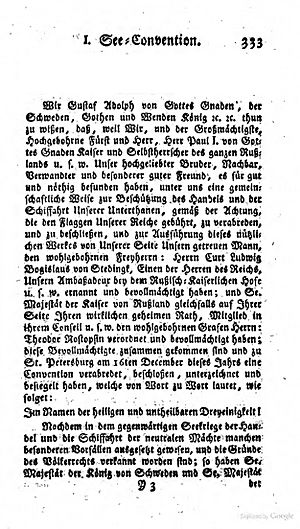Second League of Armed Neutrality facts for kids

Second League of Armed Neutrality 1800
|
|
| Type | Alliance |
|---|---|
| Context | War of the Second Coalition |
The Second League of Armed Neutrality, also known as the League of the North, was a special agreement between several powerful countries in northern Europe. These countries were Denmark–Norway, Prussia, Sweden, and Russia. They formed this group in 1800 and it lasted until 1801.
This alliance happened during a big conflict called the War of the Second Coalition. Tsar Paul I of Russia started the idea for this league. It was like a second try at an earlier group, the First League of Armed Neutrality from 1780. That first group had been very good at protecting its members' ships during the American War of Independence. However, the Second League didn't have as much success.
Contents
Why the League Was Formed: Protecting Ships
The main reason for the Second League was to keep neutral ships safe. During wartime, the Royal Navy (Britain's navy) often stopped and searched ships from neutral countries. They were looking for "contraband," which meant military supplies or other goods going to France. Britain wanted to stop trade with France.
The countries in the League wanted to protect their trading ships from being searched. They felt that as neutral nations, their ships should be able to travel freely.
Britain's Reaction and the League's End
The British government saw the League as a way for these countries to help France. They weren't worried about keeping Russia happy at the time. So, Britain decided to act.
The Battle of Copenhagen
In 1801, Britain attacked Denmark. This attack is known as the First Battle of Copenhagen. Britain damaged many of Denmark's ships. This forced Denmark to leave the League. Britain also took control of the Danish West Indies for a short time.
Changes in Leadership and Collapse
After Denmark was attacked, Prussia invaded Hanover in April 1801. This was Prussia's way of striking back at Britain.
However, a big change happened in Russia. Tsar Paul I was assassinated in March 1801. His son, Alexander I, became the new Tsar. Alexander I changed Russia's policy. Because of this, the alliance quickly fell apart. Russia later joined Britain to fight against Napoleonic France.
What Happened Later: The Idea of Neutrality
Even though the Second League didn't last long, the idea of "armed neutrality" came up again later. In the 1860s, during the American Civil War, there was a brief talk about forming a third league. This was after a British ship was stopped by the US Navy. Two diplomats from the Confederate side were taken off the ship.
In the end, Britain and France didn't form a new league. But they both agreed on the important idea of "freedom of the seas." This means that ships from neutral countries should be able to travel and trade without being stopped during a war. Both countries stayed neutral during the American Civil War.

